Dragon Quest, previously published as Dragon Warrior in North America until 2005, is a series of role-playing games created by Japanese game designers Armor Project, Bird Studio and Sugiyama Kobo to its publisher Enix, with all of the involved parties co-owning the copyright of the series since then. The games are published by Square Enix since its inception, with localized remakes and ports of later installments for the Nintendo DS, Nintendo 3DS, and Nintendo Switch being published by Nintendo outside of Japan. With its first game published in 1986, there are eleven main-series games, along with numerous spin-off games. In addition, there have been numerous manga, anime and novels published under the franchise, with nearly every game in the main series having a related adaptation.

Dragon Quest II: Luminaries of the Legendary Line, titled Dragon Warrior II when initially localized to North America, is a role-playing video game developed by Chunsoft and published by Enix in 1987 for the Nintendo Entertainment System as a part of the Dragon Quest series. Enix's U.S. subsidiary published the American release, Dragon Warrior II, for the Nintendo Entertainment System in 1990. Dragon Quest II is set one hundred years after the events of the first game.

Dragon Quest IV: Chapters of the Chosen, titled Dragon Warrior IV when initially localized to North America, is a role-playing video game, the fourth installment of the Dragon Quest video game series developed by Chunsoft and published by Enix, and the first of the Zenithian Trilogy. It was originally released for the Famicom on 11 February 1990 in Japan. A North American NES version followed in October 1992, and would be the last Dragon Quest game localized and published by Enix's Enix America Corporation subsidiary prior to its closure in November 1995, as well as the last Dragon Quest game to be localized into English prior to the localization of Dragon Warrior Monsters in December 1999. The game was remade by Heartbeat for the PlayStation, which eventually was available as an Ultimate Hits game. The remake was ported by ArtePiazza to the Nintendo DS, released in Japan November 2007 and worldwide in September 2008. A mobile version based on the Nintendo DS remake was released in 2014 for Android and iOS.
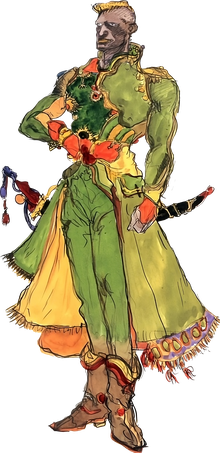
Leo Cristophe more commonly referred to as General Leo, is a character introduced in the 1994 role-playing video game Final Fantasy VI by Square Enix. An honorable soldier in the game's Gestahlian Empire that refused the magical energy infusion given to his compatriots, he appears in the first half of the game helping to ensure his Emperor's expansionist goals and is betrayed in the end. He has since appeared in other games related to the Final Fantasy franchise, including Dissidia Final Fantasy Opera Omnia, where he is voiced by Masashi Sugawara.
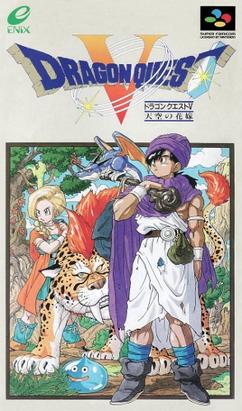
Dragon Quest V: Hand of the Heavenly Bride is a role-playing video game and the fifth installment in the Dragon Quest video game series, second of the Zenithian Trilogy. Originally developed by Chunsoft and published by Enix Corporation, Dragon Quest V was the first title in the series to be released for the Super Famicom video game console in Japan in September 1992. Dragon Quest V was the first game in the series to not be released in America due to programming issues at the time.
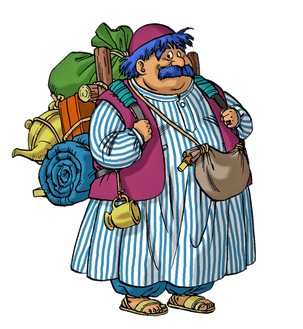
Torneko is a character in the 1990 video game Dragon Quest IV, one of its heroes. He also appears as the star of multiple games in the Mystery Dungeon series, being used for the first entry to make the series more appealing by using a recognizable brand. He is among the most recurring characters in the Dragon Quest series.
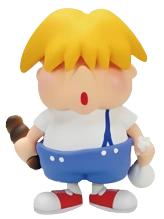
Porky Minch, known in the localization as Pokey Minch, is a character in the Mother series, also called EarthBound. He is one of the main antagonists of EarthBound, and the main antagonist of its sequel, Mother 3. He is the neighbor of the protagonist, Ness, but eventually finds himself under the influence of the main antagonist, Giygas, whom he aides in the final battle. He eventually flees after Giygas' defeat. In Mother 3, he is responsible for much death and destruction, having traveled through time and manipulating an island of people to suit his whims.

Dragon Quest: Your Story is a 2019 Japanese 3D CG anime film based on the Dragon Quest series of video games, adapting the storyline of the 1992 video game Dragon Quest V. It was released in Japan by Toho on August 2, 2019 with an international release on Netflix on February 13, 2020.
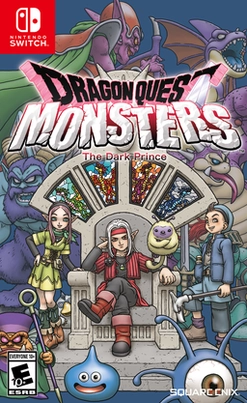
Dragon Quest Monsters: The Dark Prince is a 2023 role-playing video game developed by Tose and published by Square Enix for the Nintendo Switch. It is the seventh game in the Dragon Quest Monsters series following Dragon Quest Monsters: Joker 3 and the first to be released outside of Japan since Joker 2 in 2011. The game received mixed reviews from critics and sold a million copies by January 2024. It is the last Dragon Quest game to be released during Akira Toriyama's lifetime.
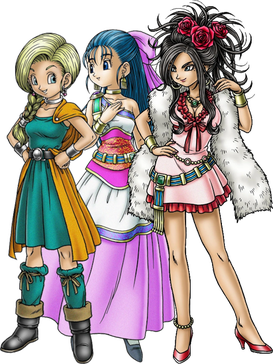
Bianca, Nera, and Debora are three female characters in the video game Dragon Quest V. Where Bianca and Nera were introduced in the 1992 Super Famicom release of the game, Debora was introduced in the 2008 Nintendo DS release. They are all three major characters in the game, with their significance depending on which of the three the protagonist marries. Bianca is the protagonist's childhood friend, while Nera and Debora are sisters whom he becomes acquainted with later in life. Whomever is chosen, the protagonist will marry them before eventually giving birth to two children, with whom they work together to defeat the main antagonist, Grandmaster Nimzo.
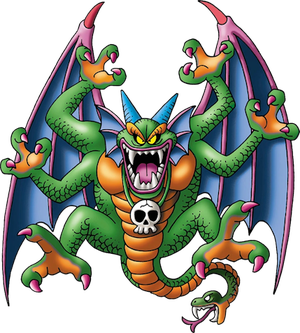
Malroth, known in Japan as Sidoh (シドー), is a character in the video game Dragon Quest II. He is its final boss, though he is rarely mentioned and never seen until he is fought at the end of the game. His boss battle was notable for its difficulty, particularly due to his use of the spell Fullheal, which recovered his health points in full. His design was created by Akira Toriyama. He also appears as a main character in the game Dragon Quest Builders 2 as a young man with no memories, assisting the protagonist in surviving and rebuilding a world, while grappling with strange voices and his inability to create things. His appearance in Dragon Quest Builders 2 earned positive reception, praised for enhancing the game and creating heartfelt moments in the game.

Puff-puff is an onomatopoeia that conveys a woman's breasts being rubbed in someone's face. It was first created by Akira Toriyama, creator of Dragon Ball and lead artist of Dragon Quest, having it featured in both. In Dragon Quest, it appears in multiple games as a service a character may receive. It has been featured in a non-sexual way in Dragon Quest as well, such as two Slimes being used to simulate the act or swapping the performer for a man, which has been criticized for lacking consent by critics. It has been routinely censored in the Dragon Quest series in English until Dragon Quest XI. Multiple video games in other series include the puff-puff scene or make references to it, including 3D Dot Game Heroes, Yakuza: Like a Dragon, Final Fantasy XIV, and Dragon Ball Xenoverse.
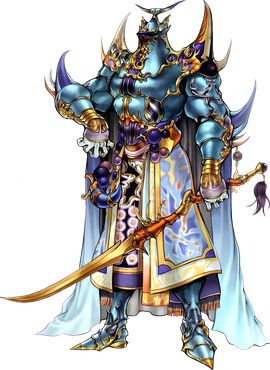
Exdeath is a character introduced in the 1992 Square Enix role-playing video game Final Fantasy V, serving as the game's antagonist. Created by Hironobu Sakaguchi, the warlock Exdeath is a sentient tree that has taken on a humanoid form, seeking to control the power of the Void. Though he is able to obtain it, while fighting the protagonists it consumes him as well, and he re-emerges as a being known as Neo Exdeath. Exdeath has since appeared in various other titles and promotions related to the Final Fantasy franchise, including the Dissida Final Fantasy games, where he is voiced by Gerald C. Rivers in English and Tarō Ishida in Japanese, with Naomi Kusumi later taking over the latter's role after Ishida's death.
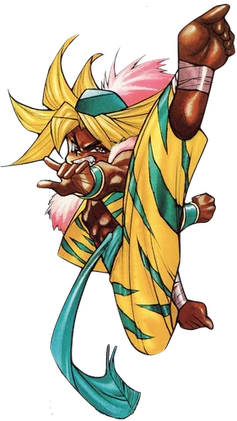
Kevin is a character in the 1995 video game Trials of Mana. He is one of its six protagonists, able to be selected as either the main character or a supporting character to one of the others. He is the prince of the kingdom of Ferolia, leaving after learning the truth of his father's nature. He is connected to the character Charlotte, who was intended by the design team to have romantic elements featured with him, which were excluded due to a lack of room in the game. Her design was created by Nobuteru Yūki and Koichi Ishii, his design inspired by Goku from Dragon Ball.

Alena is a character in the 1990 video game Dragon Quest IV, one of its main characters. She is the star of the second chapter, going out to explore the world and become a strong warrior with her retainers Kiryl and Borya, before discovering her kingdom wiped out. She later joins with the protagonist of the game in their quest to defeat the leader of the monsters, Psaro, and save the world. Her design was created by Akira Toriyama, and she is voiced in Japanese by Shoko Nakagawa. She is a fan favorite Dragon Quest IV character, noted as a strong female character by multiple critics, one from RPGFan noting how rare this was on the NES.

The Hero is the protagonist of Dragon Quest V. He starts out the story as a child, the son of Pankraz, who suffers through various tragedies before growing up, getting married, and having children. Unlike previous Dragon Quest protagonists, he is not a Legendary Hero, instead being a monster tamer, a mechanic added due to the popularity of Healie from Dragon Quest IV. He was created by Yuji Horii and designed by Akira Toriyama. He appears in other works, including the film Dragon Quest: Your Story. The Hero has received positive reception, with critics commenting on how impactful his tragic life was and how iconic a design he had.
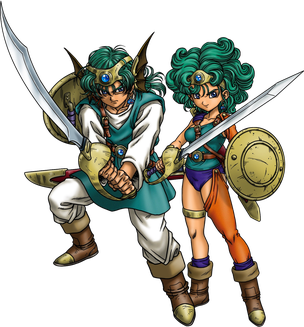
The Hero is the protagonist of Dragon Quest IV, and can be male or female. They do not have a default name, and can be given a name by the player. They are the second Hero in Dragon Quest to allow players to make them male or female, and the first to give the female Hero a distinct design. During the course of the story, the game's antagonist, Psaro, causes the death of their village, including their friend Eliza. They journey to defeat Psaro, joining other characters along the way.
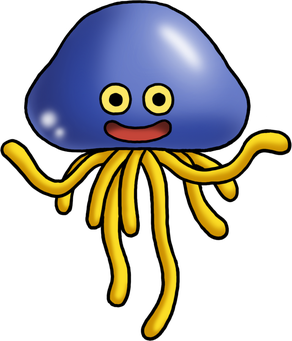
Healie is a character in the 1990 video game Dragon Quest IV. He is a Cureslime who aspires to become a human, joining the warrior Ragnar McRyan in his quest to rescue kidnapped children from minions of Psaro. He is a Cureslime, a variant of the Slime monster from the series. He was created by Yuji Horii and designed by Akira Toriyama. Due to his popularity with fans, Horii elected to expand upon the idea of having monsters as companion, adding it as a game mechanic to the sequel, Dragon Quest V. He has since appeared in other Dragon Quest games, including Dragon Quest Monsters: The Dark Prince, where he is seen in a human form. He has been among the more popular companions in the series, praised by critics for being cute and a reliable partner to Ragnar.
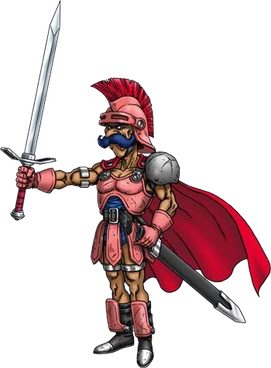
Ragnar McRyan is a character in the 1990 video game Dragon Quest IV. He is one of multiple characters who assist the game's Hero in their battle against the monster Psaro. He is the first playable character, and allies with the monster Healie, who aspires to become human, to rescue children kidnapped by Psaro's minions. He is created by Yuji Horii and designed by Akira Toriyama, and has a Scottish accent in the English version of the Nintendo DS remake. He has received generally positive reception, with critics noting how he represented an old-fashioned, uncomplicated type of hero that they felt is absent in newer games.

Maya and Meena are two characters in the 1990 video game Dragon Quest IV. Maya is a dancer and Meena a fortune teller. The two are sisters who set out on a journey to avenge their father's murder. They appear as the lead characters of the fourth chapter, and join the Hero in the fifth chapter to defeat the monster Psaro. They were created by Yuji Horii and designed by Akira Toriyama, and have been the subject of praise for both their designs and concepts, particularly Meena's use of tarot cards as weapons and Maya's beauty. The music played for the pair has also received praise, with critics identifying folk music and Middle Eastern music inspirations for their theme.



















